Financial Systems and Auditing Report: Risk, Planning, and Reporting
VerifiedAdded on 2019/12/04
|15
|4081
|118
Report
AI Summary
This report delves into the core concepts of finance systems and auditing, examining business risks, control systems, and fraud detection methods. It analyzes the operational activities of Tesco and FA Jet Ltd, identifying components of business risk such as employee turnover, technological failures, and regulatory compliance issues. The report assesses the effectiveness of internal control systems, suggesting improvements like dual control systems to mitigate fraud risks. Furthermore, it outlines the audit planning process, including scope, materiality, and audit risk, and details various audit tests like risk assessment procedures, tests of controls, substantive tests of transactions, analytical procedures, and tests for details of balances. The report also includes drafts of an audit report and a management letter, providing a comprehensive overview of the auditing process and its practical applications.
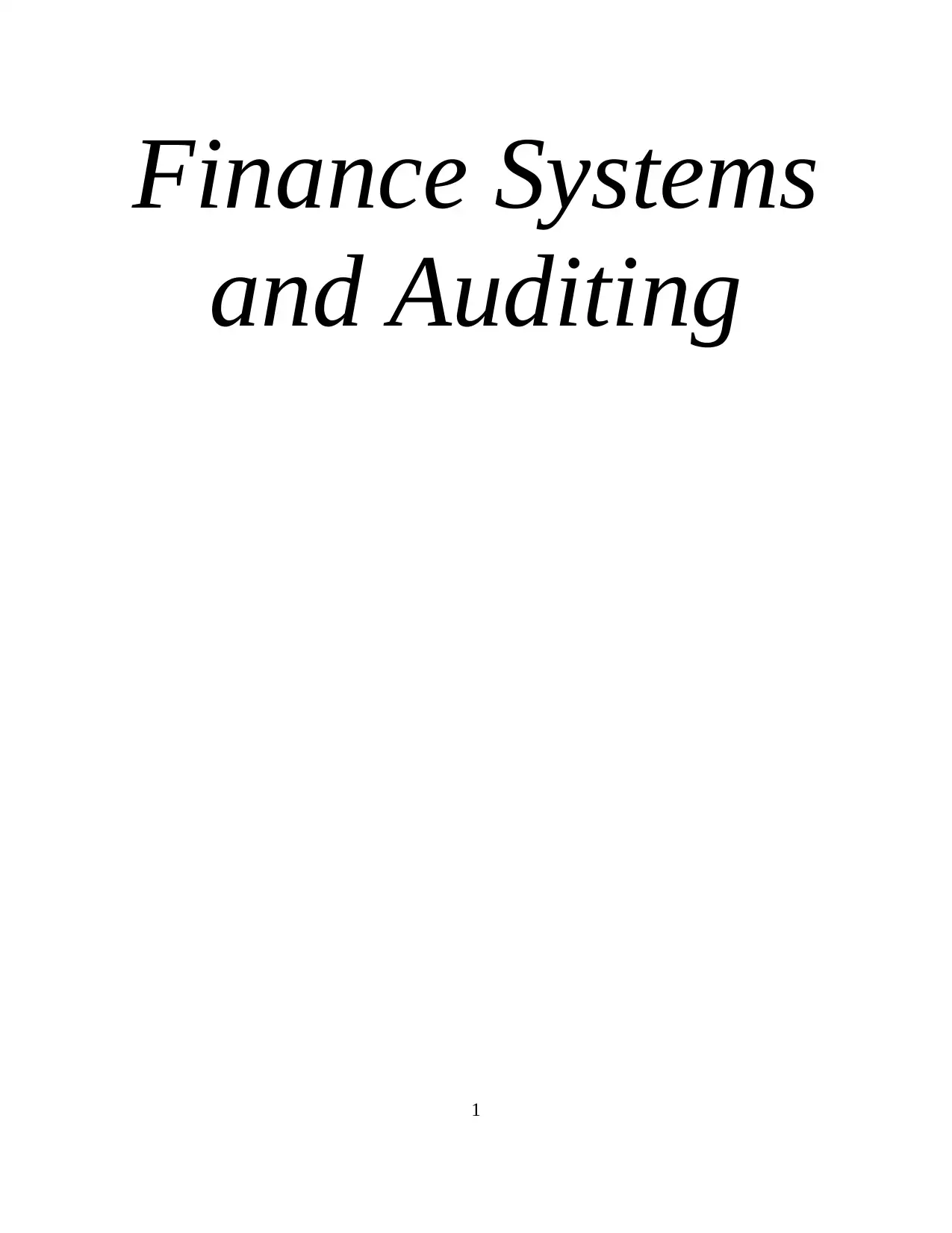
Finance Systems
and Auditing
1
and Auditing
1
Paraphrase This Document
Need a fresh take? Get an instant paraphrase of this document with our AI Paraphraser
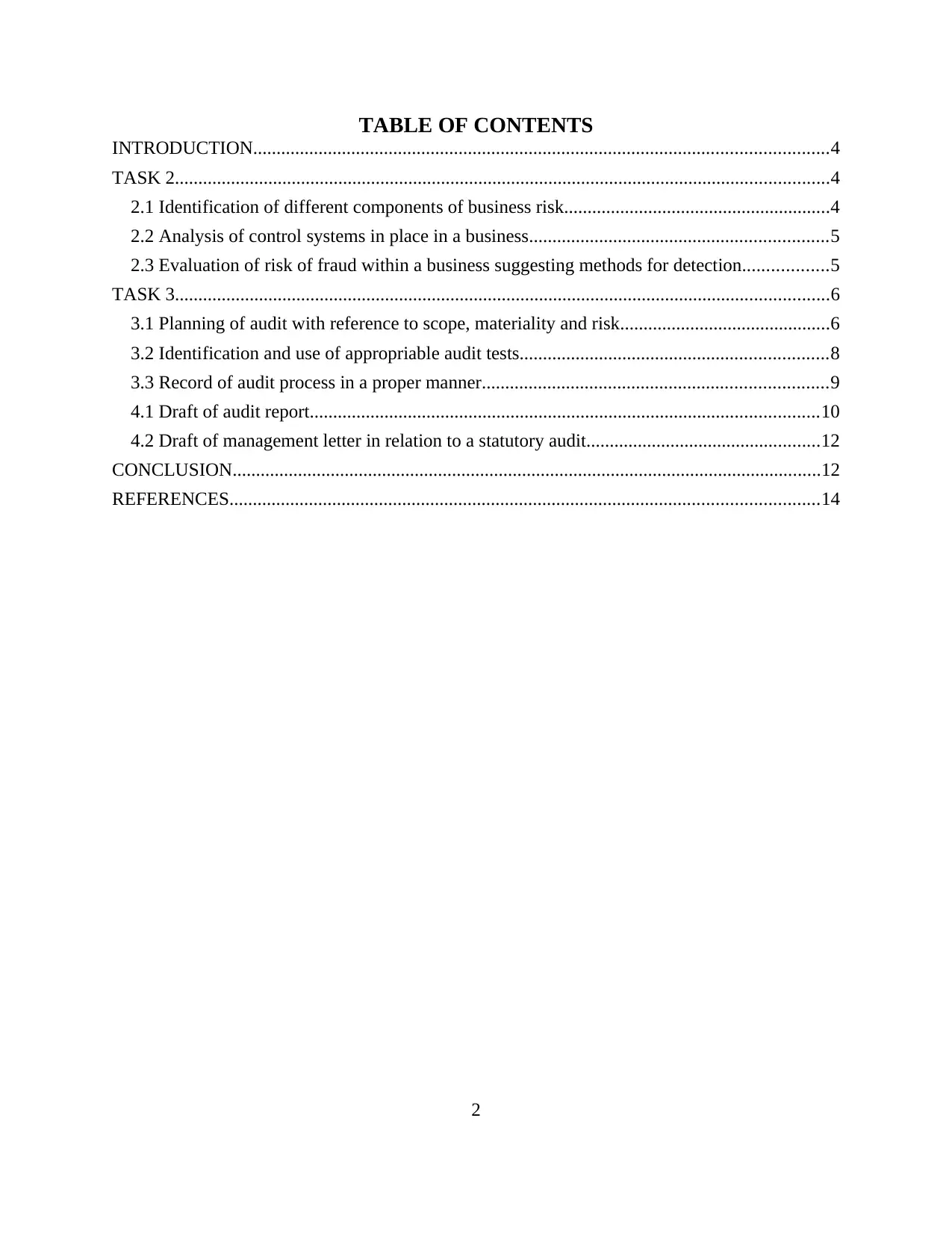
TABLE OF CONTENTS
INTRODUCTION...........................................................................................................................4
TASK 2............................................................................................................................................4
2.1 Identification of different components of business risk.........................................................4
2.2 Analysis of control systems in place in a business................................................................5
2.3 Evaluation of risk of fraud within a business suggesting methods for detection..................5
TASK 3............................................................................................................................................6
3.1 Planning of audit with reference to scope, materiality and risk.............................................6
3.2 Identification and use of appropriable audit tests..................................................................8
3.3 Record of audit process in a proper manner..........................................................................9
4.1 Draft of audit report.............................................................................................................10
4.2 Draft of management letter in relation to a statutory audit..................................................12
CONCLUSION..............................................................................................................................12
REFERENCES..............................................................................................................................14
2
INTRODUCTION...........................................................................................................................4
TASK 2............................................................................................................................................4
2.1 Identification of different components of business risk.........................................................4
2.2 Analysis of control systems in place in a business................................................................5
2.3 Evaluation of risk of fraud within a business suggesting methods for detection..................5
TASK 3............................................................................................................................................6
3.1 Planning of audit with reference to scope, materiality and risk.............................................6
3.2 Identification and use of appropriable audit tests..................................................................8
3.3 Record of audit process in a proper manner..........................................................................9
4.1 Draft of audit report.............................................................................................................10
4.2 Draft of management letter in relation to a statutory audit..................................................12
CONCLUSION..............................................................................................................................12
REFERENCES..............................................................................................................................14
2
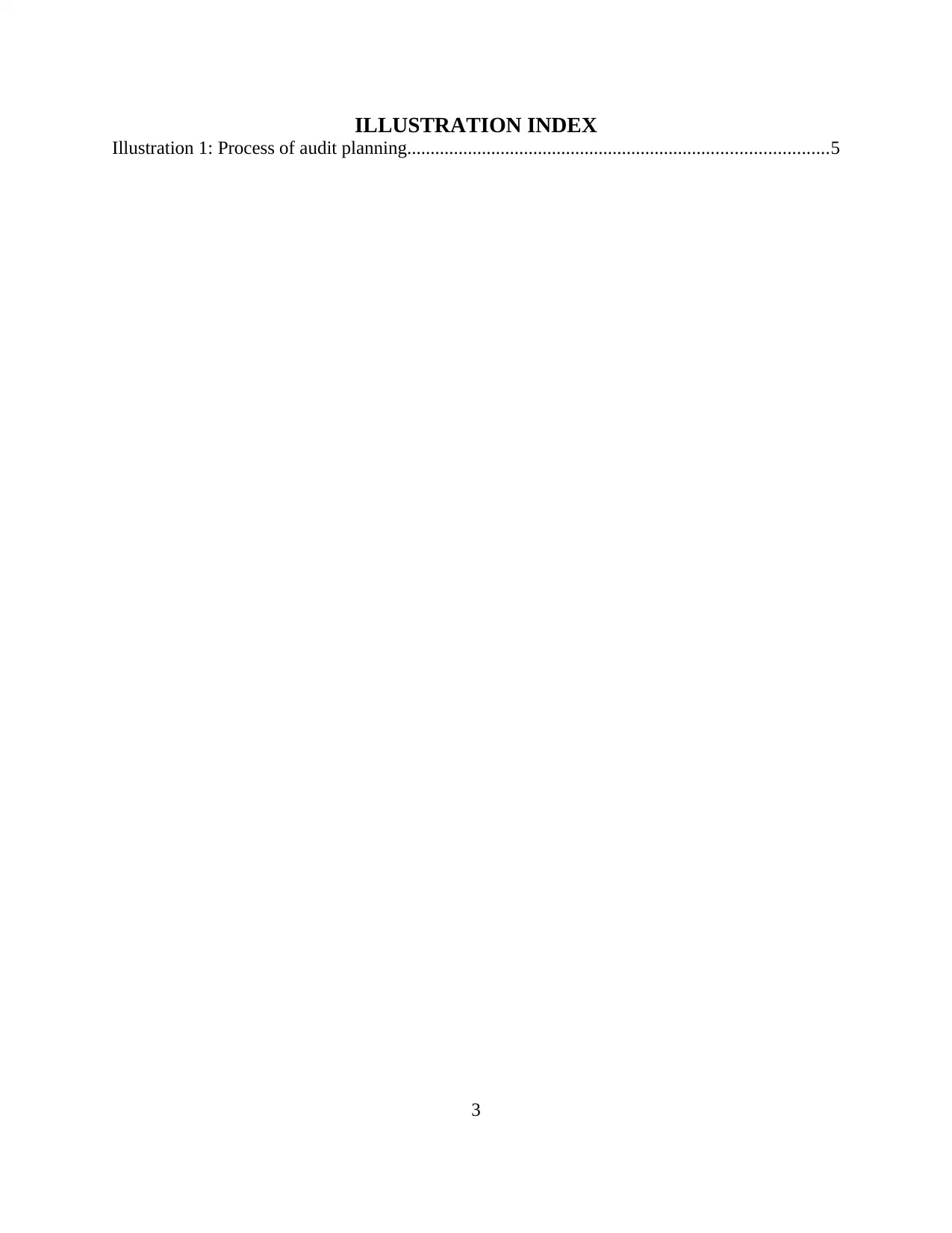
ILLUSTRATION INDEX
Illustration 1: Process of audit planning..........................................................................................5
3
Illustration 1: Process of audit planning..........................................................................................5
3
⊘ This is a preview!⊘
Do you want full access?
Subscribe today to unlock all pages.

Trusted by 1+ million students worldwide
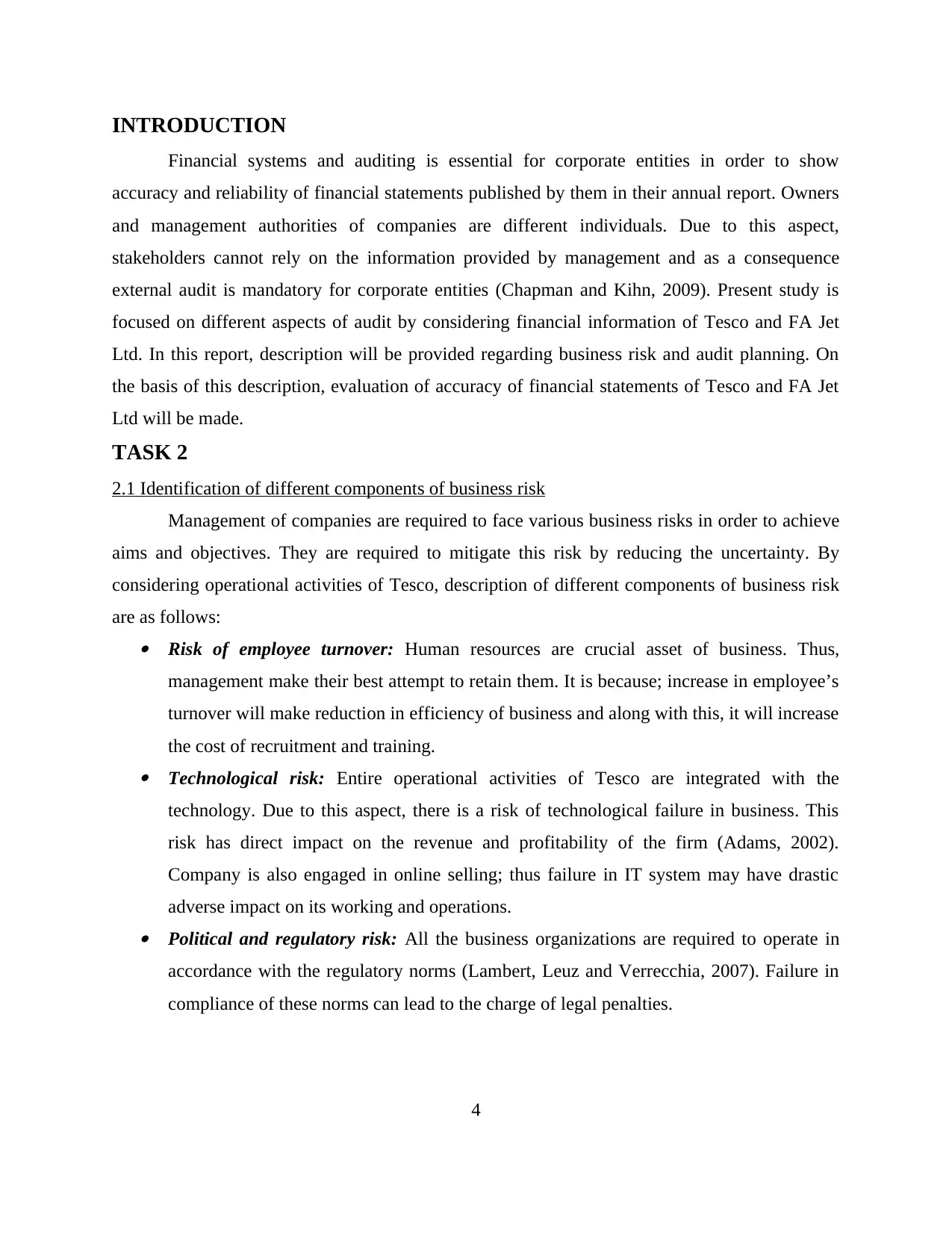
INTRODUCTION
Financial systems and auditing is essential for corporate entities in order to show
accuracy and reliability of financial statements published by them in their annual report. Owners
and management authorities of companies are different individuals. Due to this aspect,
stakeholders cannot rely on the information provided by management and as a consequence
external audit is mandatory for corporate entities (Chapman and Kihn, 2009). Present study is
focused on different aspects of audit by considering financial information of Tesco and FA Jet
Ltd. In this report, description will be provided regarding business risk and audit planning. On
the basis of this description, evaluation of accuracy of financial statements of Tesco and FA Jet
Ltd will be made.
TASK 2
2.1 Identification of different components of business risk
Management of companies are required to face various business risks in order to achieve
aims and objectives. They are required to mitigate this risk by reducing the uncertainty. By
considering operational activities of Tesco, description of different components of business risk
are as follows: Risk of employee turnover: Human resources are crucial asset of business. Thus,
management make their best attempt to retain them. It is because; increase in employee’s
turnover will make reduction in efficiency of business and along with this, it will increase
the cost of recruitment and training. Technological risk: Entire operational activities of Tesco are integrated with the
technology. Due to this aspect, there is a risk of technological failure in business. This
risk has direct impact on the revenue and profitability of the firm (Adams, 2002).
Company is also engaged in online selling; thus failure in IT system may have drastic
adverse impact on its working and operations. Political and regulatory risk: All the business organizations are required to operate in
accordance with the regulatory norms (Lambert, Leuz and Verrecchia, 2007). Failure in
compliance of these norms can lead to the charge of legal penalties.
4
Financial systems and auditing is essential for corporate entities in order to show
accuracy and reliability of financial statements published by them in their annual report. Owners
and management authorities of companies are different individuals. Due to this aspect,
stakeholders cannot rely on the information provided by management and as a consequence
external audit is mandatory for corporate entities (Chapman and Kihn, 2009). Present study is
focused on different aspects of audit by considering financial information of Tesco and FA Jet
Ltd. In this report, description will be provided regarding business risk and audit planning. On
the basis of this description, evaluation of accuracy of financial statements of Tesco and FA Jet
Ltd will be made.
TASK 2
2.1 Identification of different components of business risk
Management of companies are required to face various business risks in order to achieve
aims and objectives. They are required to mitigate this risk by reducing the uncertainty. By
considering operational activities of Tesco, description of different components of business risk
are as follows: Risk of employee turnover: Human resources are crucial asset of business. Thus,
management make their best attempt to retain them. It is because; increase in employee’s
turnover will make reduction in efficiency of business and along with this, it will increase
the cost of recruitment and training. Technological risk: Entire operational activities of Tesco are integrated with the
technology. Due to this aspect, there is a risk of technological failure in business. This
risk has direct impact on the revenue and profitability of the firm (Adams, 2002).
Company is also engaged in online selling; thus failure in IT system may have drastic
adverse impact on its working and operations. Political and regulatory risk: All the business organizations are required to operate in
accordance with the regulatory norms (Lambert, Leuz and Verrecchia, 2007). Failure in
compliance of these norms can lead to the charge of legal penalties.
4
Paraphrase This Document
Need a fresh take? Get an instant paraphrase of this document with our AI Paraphraser

Treasury risk: This risk is raised due to poor cash and debt management. It is because;
with the decrease in liquidity, there is high risk of financial crisis for business. In addition
to this, company have to face risk of fluctuations in foreign exchange risk because they
are directly involved in the transactions of import and export.
2.2 Analysis of control systems in place in a business
Effective internal control is essential for all the business organizations in order to assure
accuracy and prevention of financial frauds. With the suitable control system, management of
Tesco will be ensuring that there is no possibility of material misstatement and books of accounts
which contain accurate financial figures (Paulsson, 2006). By considering the annual report of
Tesco, it can be noticed that company has effective norms and procedure to manage operational
activities in an effective manner. For this aspect, management had made segregation of duties to
employees in accordance with the efficiency, qualifications and work experience. Further,
consistent accounting policies are followed by financial manager in order to avoid conflicts and
material manipulations (Vose, 2008). In regular time intervals, training programs are held by the
management in order to assure standard performance of employees. In addition to this,
operational policies of Tesco are supported by regulatory provisions in order to ensure fair
conduct.
Tesco developed internal audit team in order to undertake a risk based programme. Main
objective of this committee is to ensure fair and legal conduct in the business. For this aspect,
they had planned activities such as regular assessment of operational activities, surprise visits
and reporting. For the further improvement in control system, company is required to incorporate
dual control systems in business transaction (Annual report of Tesco, 2015). With this approach,
management can easily identify fraud, errors and other material manipulations. For example,
cash accounting and physical maintenance should be allocated to different individuals. In this
manner, mismatching of cash balance in accounting records and physical substance has been
evidenced. Similar application can be done in material purchase record (Lambert, Leuz and
Verrecchia, 2007). For this transaction, accounting should be allocated to accounting manager
while management of stock should be allocated to the store manager.
5
with the decrease in liquidity, there is high risk of financial crisis for business. In addition
to this, company have to face risk of fluctuations in foreign exchange risk because they
are directly involved in the transactions of import and export.
2.2 Analysis of control systems in place in a business
Effective internal control is essential for all the business organizations in order to assure
accuracy and prevention of financial frauds. With the suitable control system, management of
Tesco will be ensuring that there is no possibility of material misstatement and books of accounts
which contain accurate financial figures (Paulsson, 2006). By considering the annual report of
Tesco, it can be noticed that company has effective norms and procedure to manage operational
activities in an effective manner. For this aspect, management had made segregation of duties to
employees in accordance with the efficiency, qualifications and work experience. Further,
consistent accounting policies are followed by financial manager in order to avoid conflicts and
material manipulations (Vose, 2008). In regular time intervals, training programs are held by the
management in order to assure standard performance of employees. In addition to this,
operational policies of Tesco are supported by regulatory provisions in order to ensure fair
conduct.
Tesco developed internal audit team in order to undertake a risk based programme. Main
objective of this committee is to ensure fair and legal conduct in the business. For this aspect,
they had planned activities such as regular assessment of operational activities, surprise visits
and reporting. For the further improvement in control system, company is required to incorporate
dual control systems in business transaction (Annual report of Tesco, 2015). With this approach,
management can easily identify fraud, errors and other material manipulations. For example,
cash accounting and physical maintenance should be allocated to different individuals. In this
manner, mismatching of cash balance in accounting records and physical substance has been
evidenced. Similar application can be done in material purchase record (Lambert, Leuz and
Verrecchia, 2007). For this transaction, accounting should be allocated to accounting manager
while management of stock should be allocated to the store manager.
5
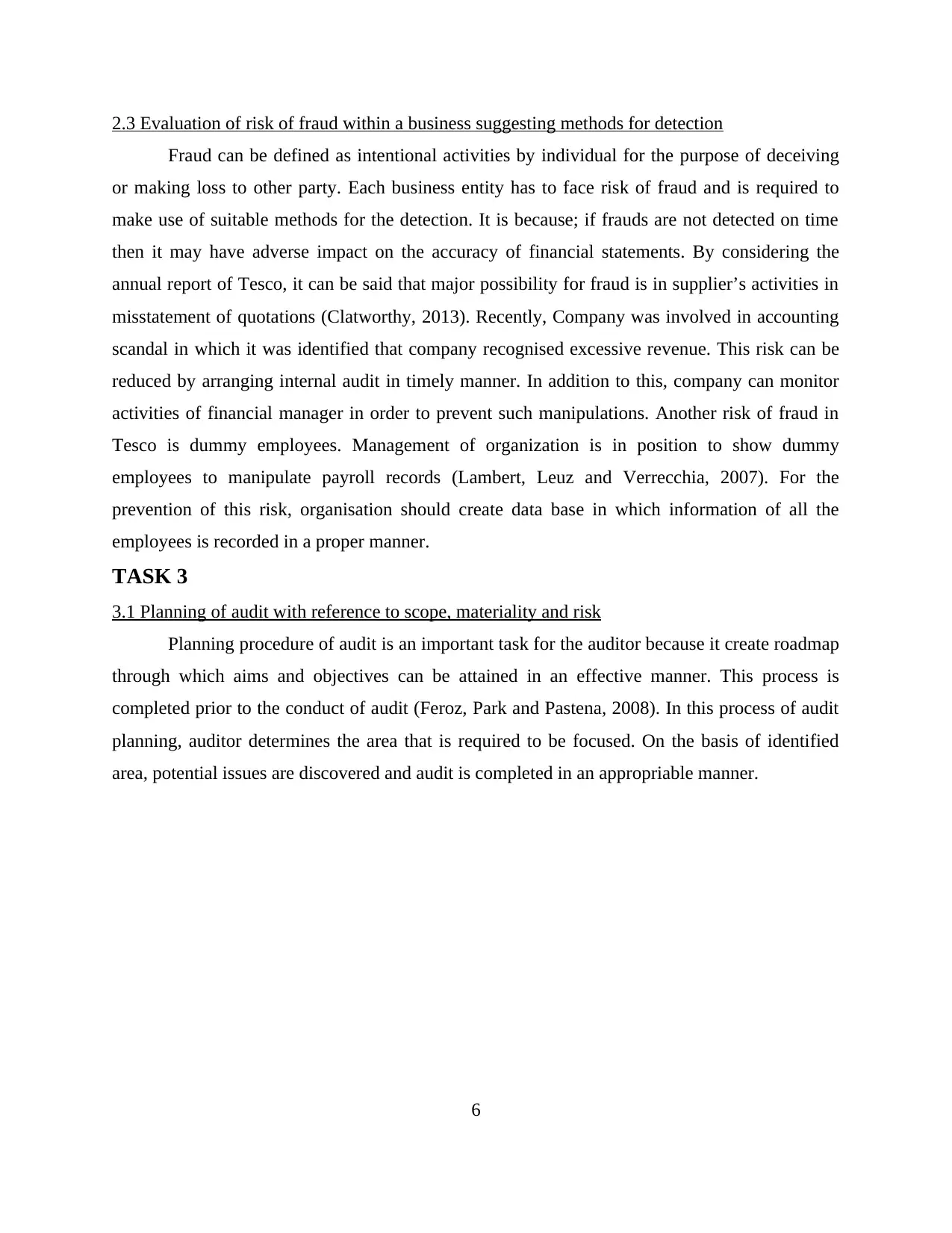
2.3 Evaluation of risk of fraud within a business suggesting methods for detection
Fraud can be defined as intentional activities by individual for the purpose of deceiving
or making loss to other party. Each business entity has to face risk of fraud and is required to
make use of suitable methods for the detection. It is because; if frauds are not detected on time
then it may have adverse impact on the accuracy of financial statements. By considering the
annual report of Tesco, it can be said that major possibility for fraud is in supplier’s activities in
misstatement of quotations (Clatworthy, 2013). Recently, Company was involved in accounting
scandal in which it was identified that company recognised excessive revenue. This risk can be
reduced by arranging internal audit in timely manner. In addition to this, company can monitor
activities of financial manager in order to prevent such manipulations. Another risk of fraud in
Tesco is dummy employees. Management of organization is in position to show dummy
employees to manipulate payroll records (Lambert, Leuz and Verrecchia, 2007). For the
prevention of this risk, organisation should create data base in which information of all the
employees is recorded in a proper manner.
TASK 3
3.1 Planning of audit with reference to scope, materiality and risk
Planning procedure of audit is an important task for the auditor because it create roadmap
through which aims and objectives can be attained in an effective manner. This process is
completed prior to the conduct of audit (Feroz, Park and Pastena, 2008). In this process of audit
planning, auditor determines the area that is required to be focused. On the basis of identified
area, potential issues are discovered and audit is completed in an appropriable manner.
6
Fraud can be defined as intentional activities by individual for the purpose of deceiving
or making loss to other party. Each business entity has to face risk of fraud and is required to
make use of suitable methods for the detection. It is because; if frauds are not detected on time
then it may have adverse impact on the accuracy of financial statements. By considering the
annual report of Tesco, it can be said that major possibility for fraud is in supplier’s activities in
misstatement of quotations (Clatworthy, 2013). Recently, Company was involved in accounting
scandal in which it was identified that company recognised excessive revenue. This risk can be
reduced by arranging internal audit in timely manner. In addition to this, company can monitor
activities of financial manager in order to prevent such manipulations. Another risk of fraud in
Tesco is dummy employees. Management of organization is in position to show dummy
employees to manipulate payroll records (Lambert, Leuz and Verrecchia, 2007). For the
prevention of this risk, organisation should create data base in which information of all the
employees is recorded in a proper manner.
TASK 3
3.1 Planning of audit with reference to scope, materiality and risk
Planning procedure of audit is an important task for the auditor because it create roadmap
through which aims and objectives can be attained in an effective manner. This process is
completed prior to the conduct of audit (Feroz, Park and Pastena, 2008). In this process of audit
planning, auditor determines the area that is required to be focused. On the basis of identified
area, potential issues are discovered and audit is completed in an appropriable manner.
6
⊘ This is a preview!⊘
Do you want full access?
Subscribe today to unlock all pages.

Trusted by 1+ million students worldwide
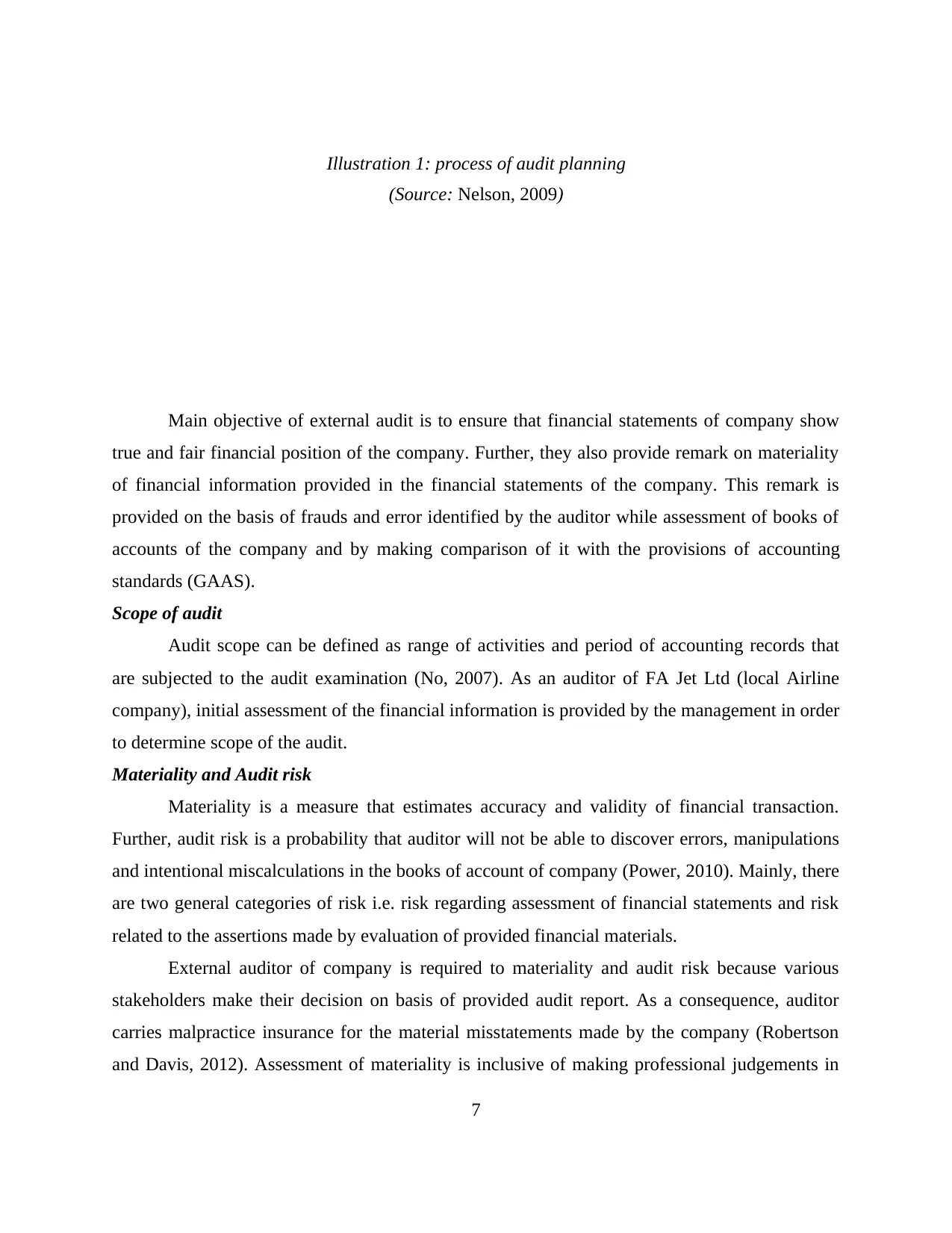
Illustration 1: process of audit planning
(Source: Nelson, 2009)
Main objective of external audit is to ensure that financial statements of company show
true and fair financial position of the company. Further, they also provide remark on materiality
of financial information provided in the financial statements of the company. This remark is
provided on the basis of frauds and error identified by the auditor while assessment of books of
accounts of the company and by making comparison of it with the provisions of accounting
standards (GAAS).
Scope of audit
Audit scope can be defined as range of activities and period of accounting records that
are subjected to the audit examination (No, 2007). As an auditor of FA Jet Ltd (local Airline
company), initial assessment of the financial information is provided by the management in order
to determine scope of the audit.
Materiality and Audit risk
Materiality is a measure that estimates accuracy and validity of financial transaction.
Further, audit risk is a probability that auditor will not be able to discover errors, manipulations
and intentional miscalculations in the books of account of company (Power, 2010). Mainly, there
are two general categories of risk i.e. risk regarding assessment of financial statements and risk
related to the assertions made by evaluation of provided financial materials.
External auditor of company is required to materiality and audit risk because various
stakeholders make their decision on basis of provided audit report. As a consequence, auditor
carries malpractice insurance for the material misstatements made by the company (Robertson
and Davis, 2012). Assessment of materiality is inclusive of making professional judgements in
7
(Source: Nelson, 2009)
Main objective of external audit is to ensure that financial statements of company show
true and fair financial position of the company. Further, they also provide remark on materiality
of financial information provided in the financial statements of the company. This remark is
provided on the basis of frauds and error identified by the auditor while assessment of books of
accounts of the company and by making comparison of it with the provisions of accounting
standards (GAAS).
Scope of audit
Audit scope can be defined as range of activities and period of accounting records that
are subjected to the audit examination (No, 2007). As an auditor of FA Jet Ltd (local Airline
company), initial assessment of the financial information is provided by the management in order
to determine scope of the audit.
Materiality and Audit risk
Materiality is a measure that estimates accuracy and validity of financial transaction.
Further, audit risk is a probability that auditor will not be able to discover errors, manipulations
and intentional miscalculations in the books of account of company (Power, 2010). Mainly, there
are two general categories of risk i.e. risk regarding assessment of financial statements and risk
related to the assertions made by evaluation of provided financial materials.
External auditor of company is required to materiality and audit risk because various
stakeholders make their decision on basis of provided audit report. As a consequence, auditor
carries malpractice insurance for the material misstatements made by the company (Robertson
and Davis, 2012). Assessment of materiality is inclusive of making professional judgements in
7
Paraphrase This Document
Need a fresh take? Get an instant paraphrase of this document with our AI Paraphraser
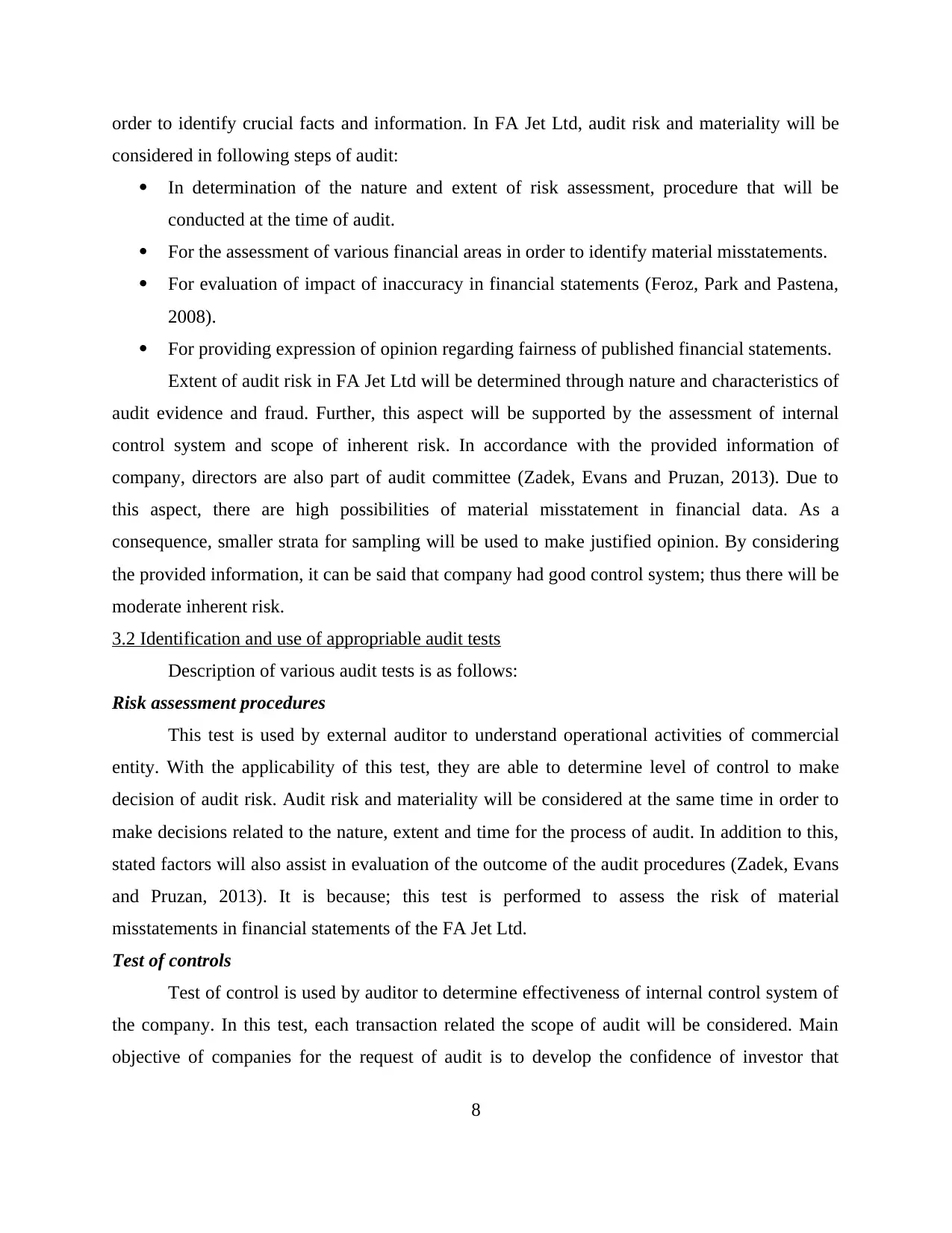
order to identify crucial facts and information. In FA Jet Ltd, audit risk and materiality will be
considered in following steps of audit:
In determination of the nature and extent of risk assessment, procedure that will be
conducted at the time of audit.
For the assessment of various financial areas in order to identify material misstatements.
For evaluation of impact of inaccuracy in financial statements (Feroz, Park and Pastena,
2008).
For providing expression of opinion regarding fairness of published financial statements.
Extent of audit risk in FA Jet Ltd will be determined through nature and characteristics of
audit evidence and fraud. Further, this aspect will be supported by the assessment of internal
control system and scope of inherent risk. In accordance with the provided information of
company, directors are also part of audit committee (Zadek, Evans and Pruzan, 2013). Due to
this aspect, there are high possibilities of material misstatement in financial data. As a
consequence, smaller strata for sampling will be used to make justified opinion. By considering
the provided information, it can be said that company had good control system; thus there will be
moderate inherent risk.
3.2 Identification and use of appropriable audit tests
Description of various audit tests is as follows:
Risk assessment procedures
This test is used by external auditor to understand operational activities of commercial
entity. With the applicability of this test, they are able to determine level of control to make
decision of audit risk. Audit risk and materiality will be considered at the same time in order to
make decisions related to the nature, extent and time for the process of audit. In addition to this,
stated factors will also assist in evaluation of the outcome of the audit procedures (Zadek, Evans
and Pruzan, 2013). It is because; this test is performed to assess the risk of material
misstatements in financial statements of the FA Jet Ltd.
Test of controls
Test of control is used by auditor to determine effectiveness of internal control system of
the company. In this test, each transaction related the scope of audit will be considered. Main
objective of companies for the request of audit is to develop the confidence of investor that
8
considered in following steps of audit:
In determination of the nature and extent of risk assessment, procedure that will be
conducted at the time of audit.
For the assessment of various financial areas in order to identify material misstatements.
For evaluation of impact of inaccuracy in financial statements (Feroz, Park and Pastena,
2008).
For providing expression of opinion regarding fairness of published financial statements.
Extent of audit risk in FA Jet Ltd will be determined through nature and characteristics of
audit evidence and fraud. Further, this aspect will be supported by the assessment of internal
control system and scope of inherent risk. In accordance with the provided information of
company, directors are also part of audit committee (Zadek, Evans and Pruzan, 2013). Due to
this aspect, there are high possibilities of material misstatement in financial data. As a
consequence, smaller strata for sampling will be used to make justified opinion. By considering
the provided information, it can be said that company had good control system; thus there will be
moderate inherent risk.
3.2 Identification and use of appropriable audit tests
Description of various audit tests is as follows:
Risk assessment procedures
This test is used by external auditor to understand operational activities of commercial
entity. With the applicability of this test, they are able to determine level of control to make
decision of audit risk. Audit risk and materiality will be considered at the same time in order to
make decisions related to the nature, extent and time for the process of audit. In addition to this,
stated factors will also assist in evaluation of the outcome of the audit procedures (Zadek, Evans
and Pruzan, 2013). It is because; this test is performed to assess the risk of material
misstatements in financial statements of the FA Jet Ltd.
Test of controls
Test of control is used by auditor to determine effectiveness of internal control system of
the company. In this test, each transaction related the scope of audit will be considered. Main
objective of companies for the request of audit is to develop the confidence of investor that
8
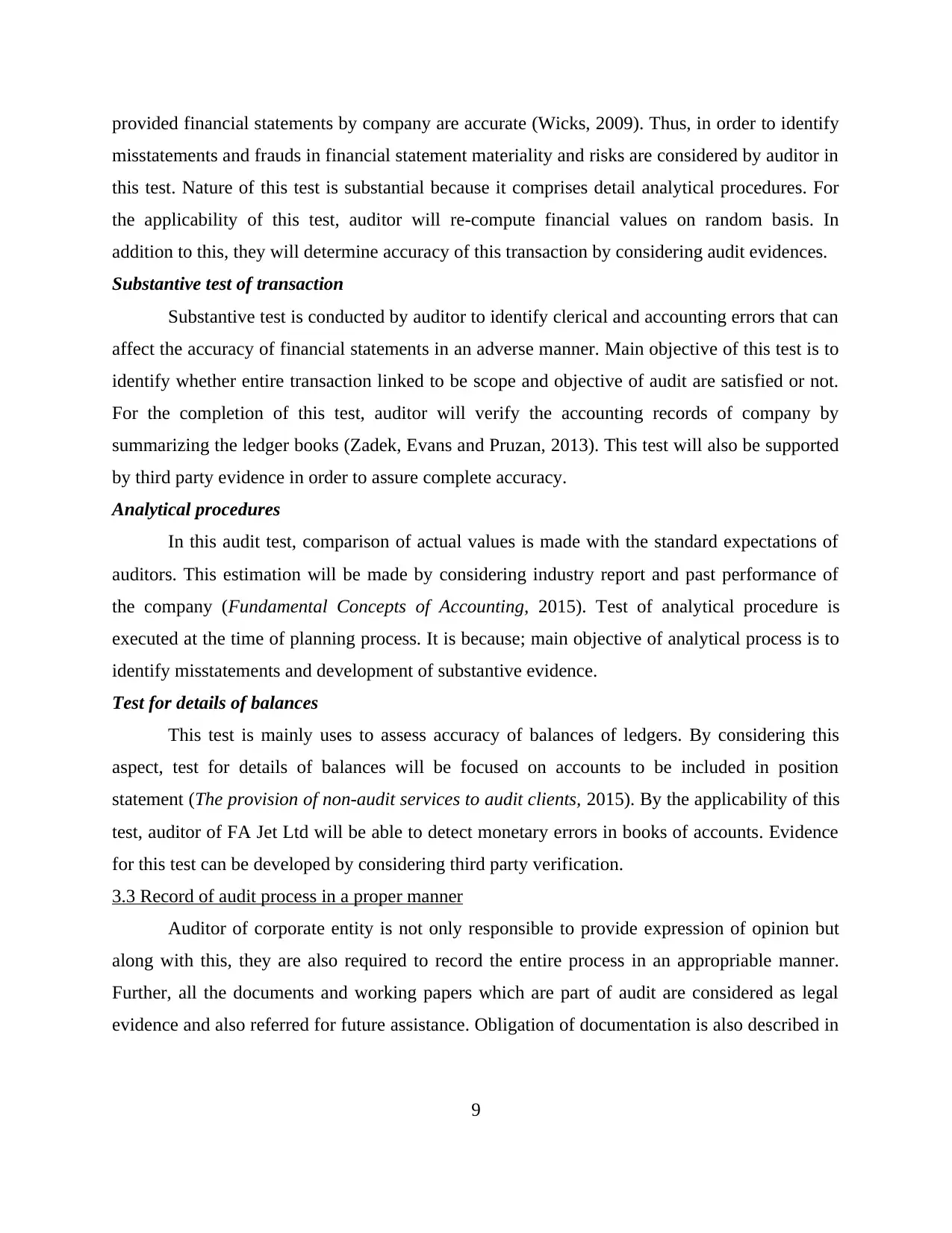
provided financial statements by company are accurate (Wicks, 2009). Thus, in order to identify
misstatements and frauds in financial statement materiality and risks are considered by auditor in
this test. Nature of this test is substantial because it comprises detail analytical procedures. For
the applicability of this test, auditor will re-compute financial values on random basis. In
addition to this, they will determine accuracy of this transaction by considering audit evidences.
Substantive test of transaction
Substantive test is conducted by auditor to identify clerical and accounting errors that can
affect the accuracy of financial statements in an adverse manner. Main objective of this test is to
identify whether entire transaction linked to be scope and objective of audit are satisfied or not.
For the completion of this test, auditor will verify the accounting records of company by
summarizing the ledger books (Zadek, Evans and Pruzan, 2013). This test will also be supported
by third party evidence in order to assure complete accuracy.
Analytical procedures
In this audit test, comparison of actual values is made with the standard expectations of
auditors. This estimation will be made by considering industry report and past performance of
the company (Fundamental Concepts of Accounting, 2015). Test of analytical procedure is
executed at the time of planning process. It is because; main objective of analytical process is to
identify misstatements and development of substantive evidence.
Test for details of balances
This test is mainly uses to assess accuracy of balances of ledgers. By considering this
aspect, test for details of balances will be focused on accounts to be included in position
statement (The provision of non-audit services to audit clients, 2015). By the applicability of this
test, auditor of FA Jet Ltd will be able to detect monetary errors in books of accounts. Evidence
for this test can be developed by considering third party verification.
3.3 Record of audit process in a proper manner
Auditor of corporate entity is not only responsible to provide expression of opinion but
along with this, they are also required to record the entire process in an appropriable manner.
Further, all the documents and working papers which are part of audit are considered as legal
evidence and also referred for future assistance. Obligation of documentation is also described in
9
misstatements and frauds in financial statement materiality and risks are considered by auditor in
this test. Nature of this test is substantial because it comprises detail analytical procedures. For
the applicability of this test, auditor will re-compute financial values on random basis. In
addition to this, they will determine accuracy of this transaction by considering audit evidences.
Substantive test of transaction
Substantive test is conducted by auditor to identify clerical and accounting errors that can
affect the accuracy of financial statements in an adverse manner. Main objective of this test is to
identify whether entire transaction linked to be scope and objective of audit are satisfied or not.
For the completion of this test, auditor will verify the accounting records of company by
summarizing the ledger books (Zadek, Evans and Pruzan, 2013). This test will also be supported
by third party evidence in order to assure complete accuracy.
Analytical procedures
In this audit test, comparison of actual values is made with the standard expectations of
auditors. This estimation will be made by considering industry report and past performance of
the company (Fundamental Concepts of Accounting, 2015). Test of analytical procedure is
executed at the time of planning process. It is because; main objective of analytical process is to
identify misstatements and development of substantive evidence.
Test for details of balances
This test is mainly uses to assess accuracy of balances of ledgers. By considering this
aspect, test for details of balances will be focused on accounts to be included in position
statement (The provision of non-audit services to audit clients, 2015). By the applicability of this
test, auditor of FA Jet Ltd will be able to detect monetary errors in books of accounts. Evidence
for this test can be developed by considering third party verification.
3.3 Record of audit process in a proper manner
Auditor of corporate entity is not only responsible to provide expression of opinion but
along with this, they are also required to record the entire process in an appropriable manner.
Further, all the documents and working papers which are part of audit are considered as legal
evidence and also referred for future assistance. Obligation of documentation is also described in
9
⊘ This is a preview!⊘
Do you want full access?
Subscribe today to unlock all pages.

Trusted by 1+ million students worldwide
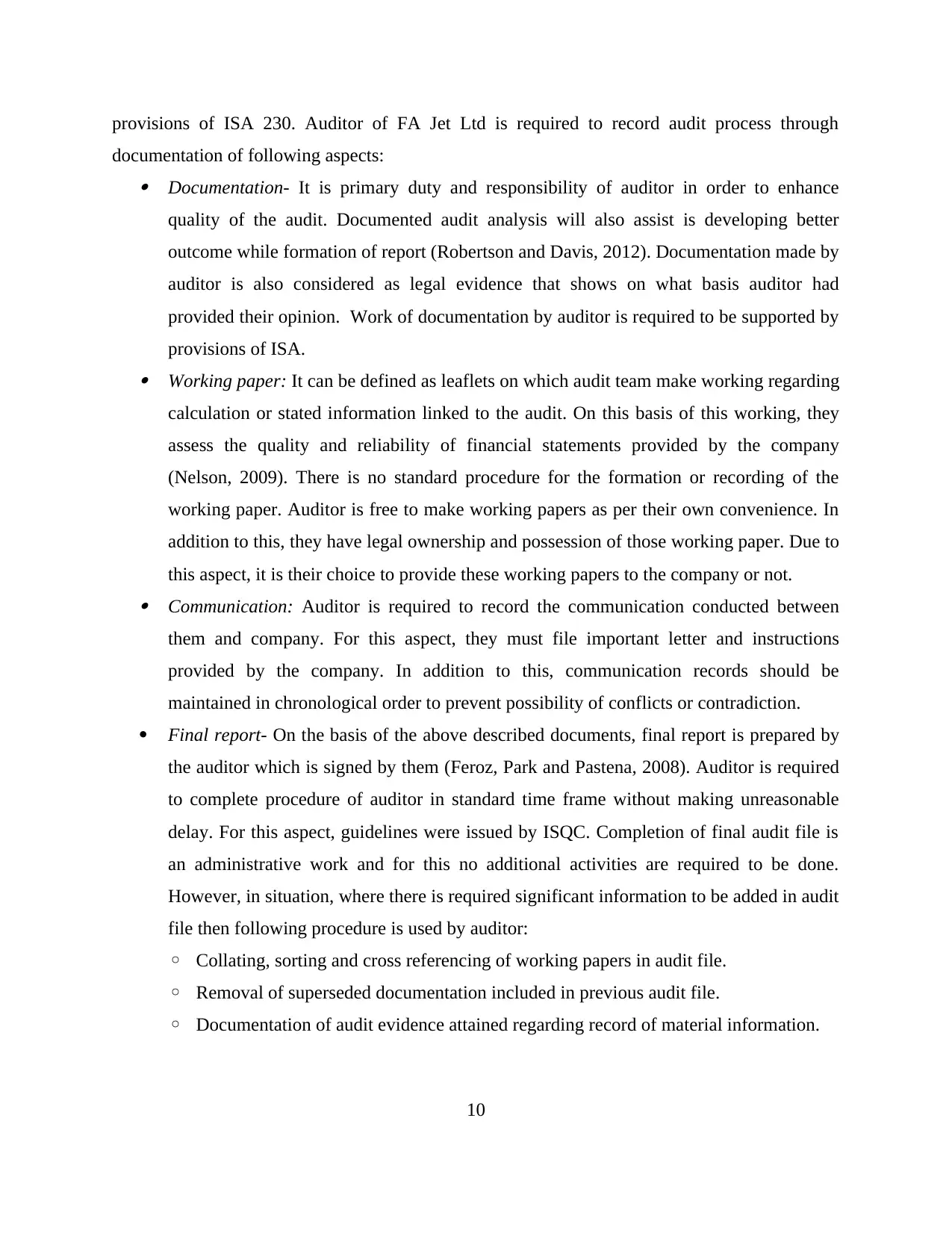
provisions of ISA 230. Auditor of FA Jet Ltd is required to record audit process through
documentation of following aspects: Documentation- It is primary duty and responsibility of auditor in order to enhance
quality of the audit. Documented audit analysis will also assist is developing better
outcome while formation of report (Robertson and Davis, 2012). Documentation made by
auditor is also considered as legal evidence that shows on what basis auditor had
provided their opinion. Work of documentation by auditor is required to be supported by
provisions of ISA. Working paper: It can be defined as leaflets on which audit team make working regarding
calculation or stated information linked to the audit. On this basis of this working, they
assess the quality and reliability of financial statements provided by the company
(Nelson, 2009). There is no standard procedure for the formation or recording of the
working paper. Auditor is free to make working papers as per their own convenience. In
addition to this, they have legal ownership and possession of those working paper. Due to
this aspect, it is their choice to provide these working papers to the company or not. Communication: Auditor is required to record the communication conducted between
them and company. For this aspect, they must file important letter and instructions
provided by the company. In addition to this, communication records should be
maintained in chronological order to prevent possibility of conflicts or contradiction.
Final report- On the basis of the above described documents, final report is prepared by
the auditor which is signed by them (Feroz, Park and Pastena, 2008). Auditor is required
to complete procedure of auditor in standard time frame without making unreasonable
delay. For this aspect, guidelines were issued by ISQC. Completion of final audit file is
an administrative work and for this no additional activities are required to be done.
However, in situation, where there is required significant information to be added in audit
file then following procedure is used by auditor:
◦ Collating, sorting and cross referencing of working papers in audit file.
◦ Removal of superseded documentation included in previous audit file.
◦ Documentation of audit evidence attained regarding record of material information.
10
documentation of following aspects: Documentation- It is primary duty and responsibility of auditor in order to enhance
quality of the audit. Documented audit analysis will also assist is developing better
outcome while formation of report (Robertson and Davis, 2012). Documentation made by
auditor is also considered as legal evidence that shows on what basis auditor had
provided their opinion. Work of documentation by auditor is required to be supported by
provisions of ISA. Working paper: It can be defined as leaflets on which audit team make working regarding
calculation or stated information linked to the audit. On this basis of this working, they
assess the quality and reliability of financial statements provided by the company
(Nelson, 2009). There is no standard procedure for the formation or recording of the
working paper. Auditor is free to make working papers as per their own convenience. In
addition to this, they have legal ownership and possession of those working paper. Due to
this aspect, it is their choice to provide these working papers to the company or not. Communication: Auditor is required to record the communication conducted between
them and company. For this aspect, they must file important letter and instructions
provided by the company. In addition to this, communication records should be
maintained in chronological order to prevent possibility of conflicts or contradiction.
Final report- On the basis of the above described documents, final report is prepared by
the auditor which is signed by them (Feroz, Park and Pastena, 2008). Auditor is required
to complete procedure of auditor in standard time frame without making unreasonable
delay. For this aspect, guidelines were issued by ISQC. Completion of final audit file is
an administrative work and for this no additional activities are required to be done.
However, in situation, where there is required significant information to be added in audit
file then following procedure is used by auditor:
◦ Collating, sorting and cross referencing of working papers in audit file.
◦ Removal of superseded documentation included in previous audit file.
◦ Documentation of audit evidence attained regarding record of material information.
10
Paraphrase This Document
Need a fresh take? Get an instant paraphrase of this document with our AI Paraphraser
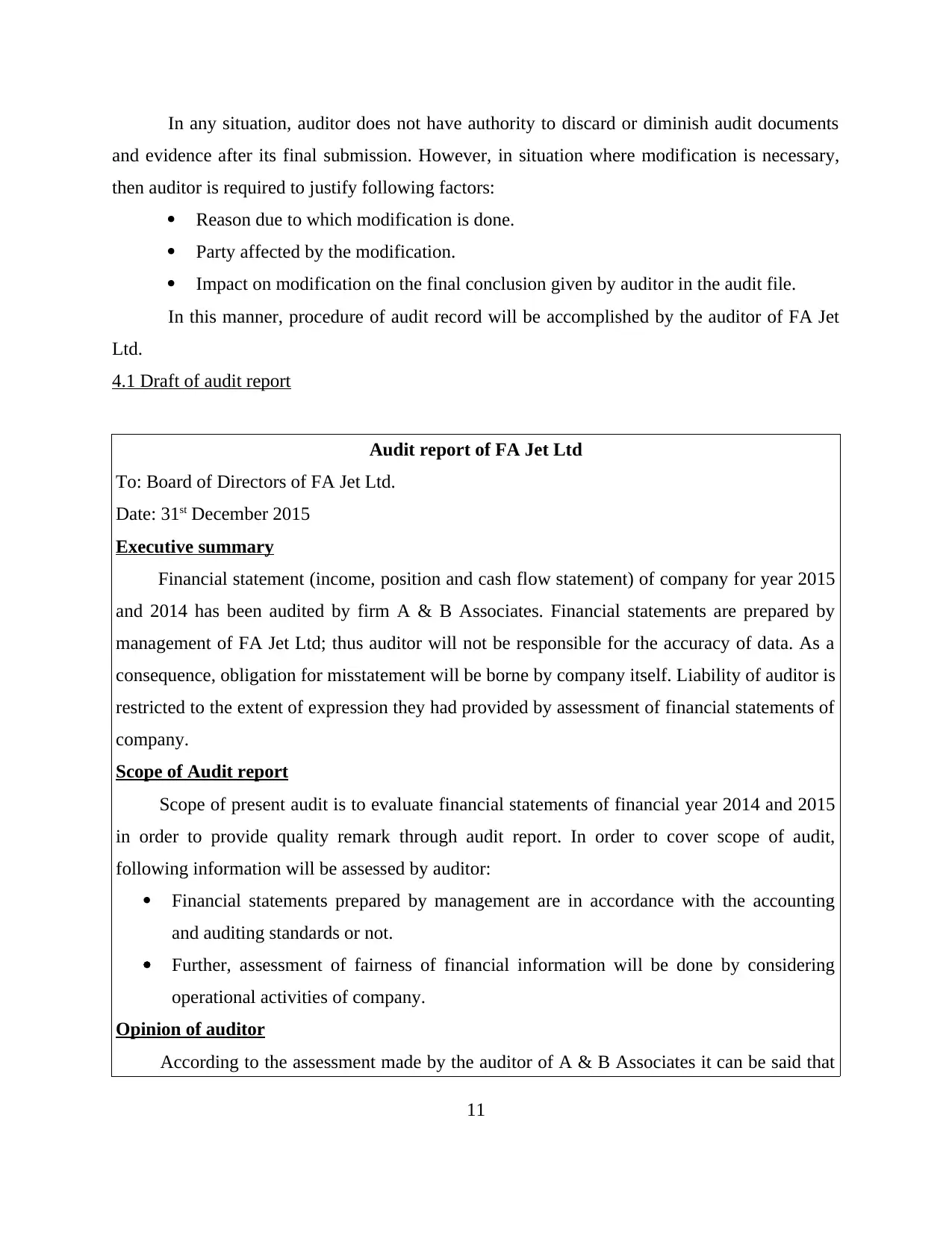
In any situation, auditor does not have authority to discard or diminish audit documents
and evidence after its final submission. However, in situation where modification is necessary,
then auditor is required to justify following factors:
Reason due to which modification is done.
Party affected by the modification.
Impact on modification on the final conclusion given by auditor in the audit file.
In this manner, procedure of audit record will be accomplished by the auditor of FA Jet
Ltd.
4.1 Draft of audit report
Audit report of FA Jet Ltd
To: Board of Directors of FA Jet Ltd.
Date: 31st December 2015
Executive summary
Financial statement (income, position and cash flow statement) of company for year 2015
and 2014 has been audited by firm A & B Associates. Financial statements are prepared by
management of FA Jet Ltd; thus auditor will not be responsible for the accuracy of data. As a
consequence, obligation for misstatement will be borne by company itself. Liability of auditor is
restricted to the extent of expression they had provided by assessment of financial statements of
company.
Scope of Audit report
Scope of present audit is to evaluate financial statements of financial year 2014 and 2015
in order to provide quality remark through audit report. In order to cover scope of audit,
following information will be assessed by auditor:
Financial statements prepared by management are in accordance with the accounting
and auditing standards or not.
Further, assessment of fairness of financial information will be done by considering
operational activities of company.
Opinion of auditor
According to the assessment made by the auditor of A & B Associates it can be said that
11
and evidence after its final submission. However, in situation where modification is necessary,
then auditor is required to justify following factors:
Reason due to which modification is done.
Party affected by the modification.
Impact on modification on the final conclusion given by auditor in the audit file.
In this manner, procedure of audit record will be accomplished by the auditor of FA Jet
Ltd.
4.1 Draft of audit report
Audit report of FA Jet Ltd
To: Board of Directors of FA Jet Ltd.
Date: 31st December 2015
Executive summary
Financial statement (income, position and cash flow statement) of company for year 2015
and 2014 has been audited by firm A & B Associates. Financial statements are prepared by
management of FA Jet Ltd; thus auditor will not be responsible for the accuracy of data. As a
consequence, obligation for misstatement will be borne by company itself. Liability of auditor is
restricted to the extent of expression they had provided by assessment of financial statements of
company.
Scope of Audit report
Scope of present audit is to evaluate financial statements of financial year 2014 and 2015
in order to provide quality remark through audit report. In order to cover scope of audit,
following information will be assessed by auditor:
Financial statements prepared by management are in accordance with the accounting
and auditing standards or not.
Further, assessment of fairness of financial information will be done by considering
operational activities of company.
Opinion of auditor
According to the assessment made by the auditor of A & B Associates it can be said that
11
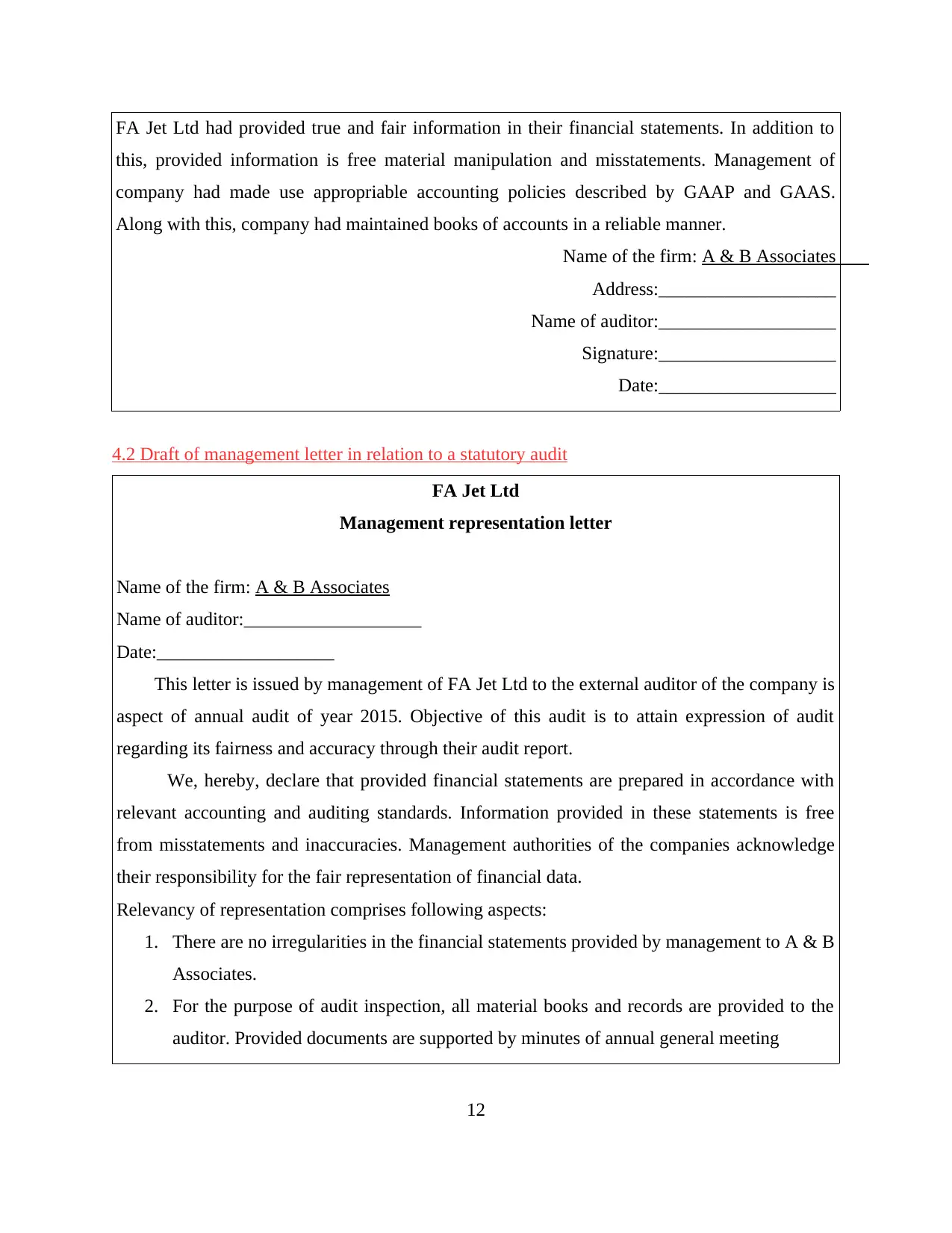
FA Jet Ltd had provided true and fair information in their financial statements. In addition to
this, provided information is free material manipulation and misstatements. Management of
company had made use appropriable accounting policies described by GAAP and GAAS.
Along with this, company had maintained books of accounts in a reliable manner.
Name of the firm: A & B Associates
Address:___________________
Name of auditor:___________________
Signature:___________________
Date:___________________
4.2 Draft of management letter in relation to a statutory audit
FA Jet Ltd
Management representation letter
Name of the firm: A & B Associates
Name of auditor:___________________
Date:___________________
This letter is issued by management of FA Jet Ltd to the external auditor of the company is
aspect of annual audit of year 2015. Objective of this audit is to attain expression of audit
regarding its fairness and accuracy through their audit report.
We, hereby, declare that provided financial statements are prepared in accordance with
relevant accounting and auditing standards. Information provided in these statements is free
from misstatements and inaccuracies. Management authorities of the companies acknowledge
their responsibility for the fair representation of financial data.
Relevancy of representation comprises following aspects:
1. There are no irregularities in the financial statements provided by management to A & B
Associates.
2. For the purpose of audit inspection, all material books and records are provided to the
auditor. Provided documents are supported by minutes of annual general meeting
12
this, provided information is free material manipulation and misstatements. Management of
company had made use appropriable accounting policies described by GAAP and GAAS.
Along with this, company had maintained books of accounts in a reliable manner.
Name of the firm: A & B Associates
Address:___________________
Name of auditor:___________________
Signature:___________________
Date:___________________
4.2 Draft of management letter in relation to a statutory audit
FA Jet Ltd
Management representation letter
Name of the firm: A & B Associates
Name of auditor:___________________
Date:___________________
This letter is issued by management of FA Jet Ltd to the external auditor of the company is
aspect of annual audit of year 2015. Objective of this audit is to attain expression of audit
regarding its fairness and accuracy through their audit report.
We, hereby, declare that provided financial statements are prepared in accordance with
relevant accounting and auditing standards. Information provided in these statements is free
from misstatements and inaccuracies. Management authorities of the companies acknowledge
their responsibility for the fair representation of financial data.
Relevancy of representation comprises following aspects:
1. There are no irregularities in the financial statements provided by management to A & B
Associates.
2. For the purpose of audit inspection, all material books and records are provided to the
auditor. Provided documents are supported by minutes of annual general meeting
12
⊘ This is a preview!⊘
Do you want full access?
Subscribe today to unlock all pages.

Trusted by 1+ million students worldwide

3. Information covered in financial statements is reliable and complete.
Senior executive officer Managing director
Name___________________ Name ___________________
Signature:___________________ Signature:___________________
Date:___________________ Date:___________________
CONCLUSION
In accordance with the present study, conclusion can be drawn that company should have
an effective control system to manage business risk in proper manner. For this aspect,
management of companies are required to monitor the business activities and to modify
strategies as per the requirements of business. In order to provide conclusive opinion, auditor is
required to plan business activities in a proper manner. For this aspect, they are required to
consider scope, materiality and risk. It is legal and ethical obligation to record entire process in
suitable manner as their works is referred as legal evidence in the future course of action.
13
Senior executive officer Managing director
Name___________________ Name ___________________
Signature:___________________ Signature:___________________
Date:___________________ Date:___________________
CONCLUSION
In accordance with the present study, conclusion can be drawn that company should have
an effective control system to manage business risk in proper manner. For this aspect,
management of companies are required to monitor the business activities and to modify
strategies as per the requirements of business. In order to provide conclusive opinion, auditor is
required to plan business activities in a proper manner. For this aspect, they are required to
consider scope, materiality and risk. It is legal and ethical obligation to record entire process in
suitable manner as their works is referred as legal evidence in the future course of action.
13
Paraphrase This Document
Need a fresh take? Get an instant paraphrase of this document with our AI Paraphraser
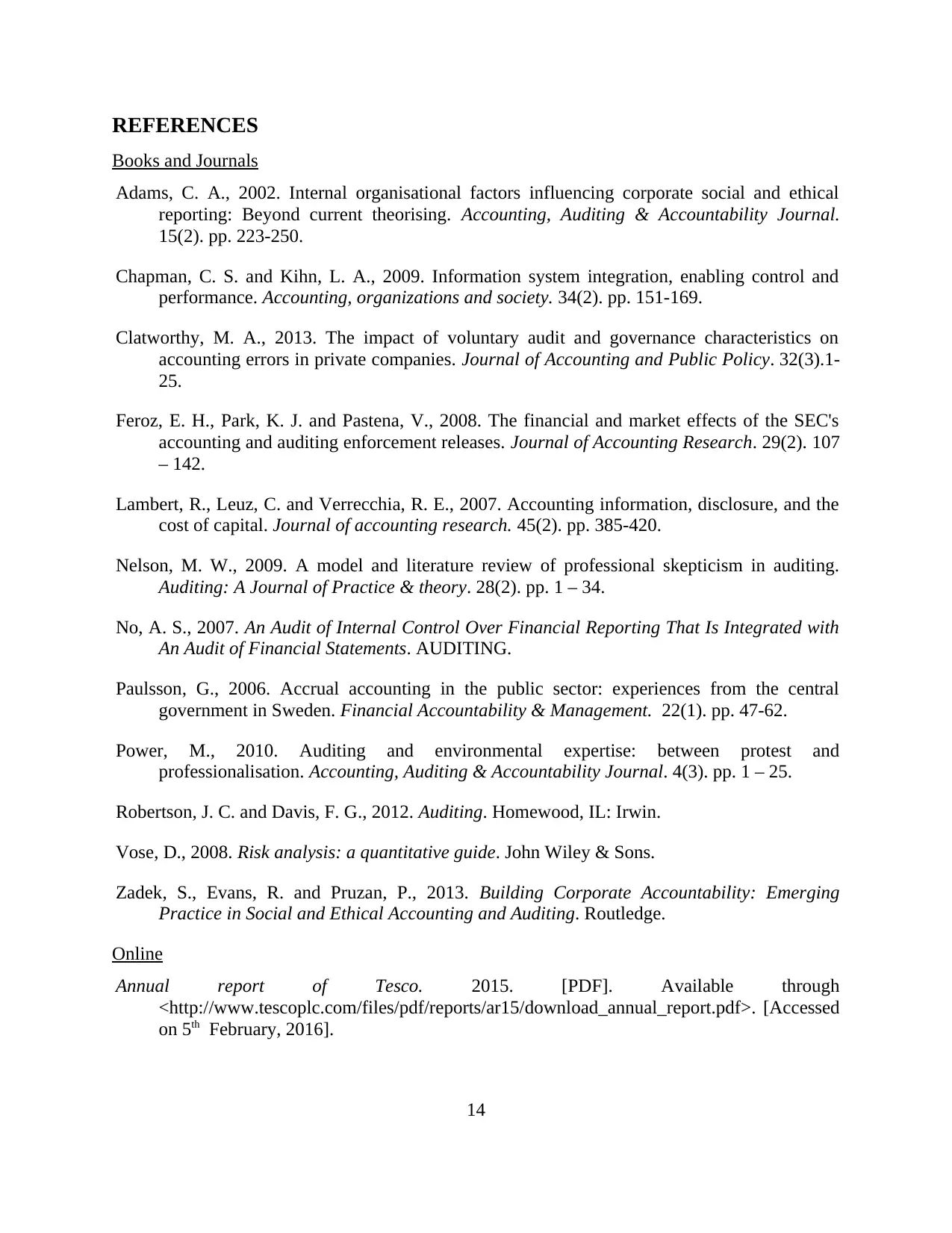
REFERENCES
Books and Journals
Adams, C. A., 2002. Internal organisational factors influencing corporate social and ethical
reporting: Beyond current theorising. Accounting, Auditing & Accountability Journal.
15(2). pp. 223-250.
Chapman, C. S. and Kihn, L. A., 2009. Information system integration, enabling control and
performance. Accounting, organizations and society. 34(2). pp. 151-169.
Clatworthy, M. A., 2013. The impact of voluntary audit and governance characteristics on
accounting errors in private companies. Journal of Accounting and Public Policy. 32(3).1-
25.
Feroz, E. H., Park, K. J. and Pastena, V., 2008. The financial and market effects of the SEC's
accounting and auditing enforcement releases. Journal of Accounting Research. 29(2). 107
– 142.
Lambert, R., Leuz, C. and Verrecchia, R. E., 2007. Accounting information, disclosure, and the
cost of capital. Journal of accounting research. 45(2). pp. 385-420.
Nelson, M. W., 2009. A model and literature review of professional skepticism in auditing.
Auditing: A Journal of Practice & theory. 28(2). pp. 1 – 34.
No, A. S., 2007. An Audit of Internal Control Over Financial Reporting That Is Integrated with
An Audit of Financial Statements. AUDITING.
Paulsson, G., 2006. Accrual accounting in the public sector: experiences from the central
government in Sweden. Financial Accountability & Management. 22(1). pp. 47-62.
Power, M., 2010. Auditing and environmental expertise: between protest and
professionalisation. Accounting, Auditing & Accountability Journal. 4(3). pp. 1 – 25.
Robertson, J. C. and Davis, F. G., 2012. Auditing. Homewood, IL: Irwin.
Vose, D., 2008. Risk analysis: a quantitative guide. John Wiley & Sons.
Zadek, S., Evans, R. and Pruzan, P., 2013. Building Corporate Accountability: Emerging
Practice in Social and Ethical Accounting and Auditing. Routledge.
Online
Annual report of Tesco. 2015. [PDF]. Available through
<http://www.tescoplc.com/files/pdf/reports/ar15/download_annual_report.pdf>. [Accessed
on 5th February, 2016].
14
Books and Journals
Adams, C. A., 2002. Internal organisational factors influencing corporate social and ethical
reporting: Beyond current theorising. Accounting, Auditing & Accountability Journal.
15(2). pp. 223-250.
Chapman, C. S. and Kihn, L. A., 2009. Information system integration, enabling control and
performance. Accounting, organizations and society. 34(2). pp. 151-169.
Clatworthy, M. A., 2013. The impact of voluntary audit and governance characteristics on
accounting errors in private companies. Journal of Accounting and Public Policy. 32(3).1-
25.
Feroz, E. H., Park, K. J. and Pastena, V., 2008. The financial and market effects of the SEC's
accounting and auditing enforcement releases. Journal of Accounting Research. 29(2). 107
– 142.
Lambert, R., Leuz, C. and Verrecchia, R. E., 2007. Accounting information, disclosure, and the
cost of capital. Journal of accounting research. 45(2). pp. 385-420.
Nelson, M. W., 2009. A model and literature review of professional skepticism in auditing.
Auditing: A Journal of Practice & theory. 28(2). pp. 1 – 34.
No, A. S., 2007. An Audit of Internal Control Over Financial Reporting That Is Integrated with
An Audit of Financial Statements. AUDITING.
Paulsson, G., 2006. Accrual accounting in the public sector: experiences from the central
government in Sweden. Financial Accountability & Management. 22(1). pp. 47-62.
Power, M., 2010. Auditing and environmental expertise: between protest and
professionalisation. Accounting, Auditing & Accountability Journal. 4(3). pp. 1 – 25.
Robertson, J. C. and Davis, F. G., 2012. Auditing. Homewood, IL: Irwin.
Vose, D., 2008. Risk analysis: a quantitative guide. John Wiley & Sons.
Zadek, S., Evans, R. and Pruzan, P., 2013. Building Corporate Accountability: Emerging
Practice in Social and Ethical Accounting and Auditing. Routledge.
Online
Annual report of Tesco. 2015. [PDF]. Available through
<http://www.tescoplc.com/files/pdf/reports/ar15/download_annual_report.pdf>. [Accessed
on 5th February, 2016].
14
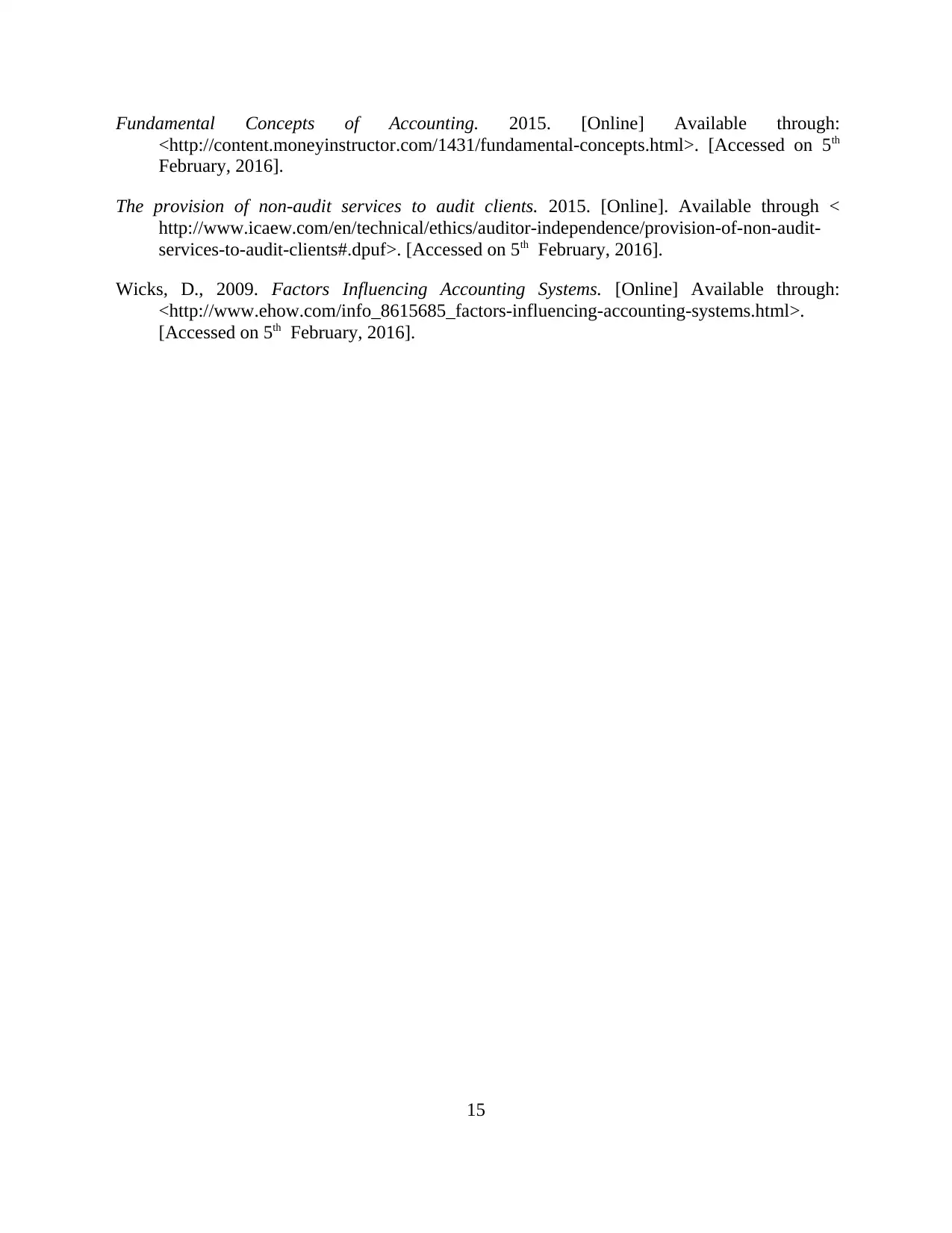
Fundamental Concepts of Accounting. 2015. [Online] Available through:
<http://content.moneyinstructor.com/1431/fundamental-concepts.html>. [Accessed on 5th
February, 2016].
The provision of non-audit services to audit clients. 2015. [Online]. Available through <
http://www.icaew.com/en/technical/ethics/auditor-independence/provision-of-non-audit-
services-to-audit-clients#.dpuf>. [Accessed on 5th February, 2016].
Wicks, D., 2009. Factors Influencing Accounting Systems. [Online] Available through:
<http://www.ehow.com/info_8615685_factors-influencing-accounting-systems.html>.
[Accessed on 5th February, 2016].
15
<http://content.moneyinstructor.com/1431/fundamental-concepts.html>. [Accessed on 5th
February, 2016].
The provision of non-audit services to audit clients. 2015. [Online]. Available through <
http://www.icaew.com/en/technical/ethics/auditor-independence/provision-of-non-audit-
services-to-audit-clients#.dpuf>. [Accessed on 5th February, 2016].
Wicks, D., 2009. Factors Influencing Accounting Systems. [Online] Available through:
<http://www.ehow.com/info_8615685_factors-influencing-accounting-systems.html>.
[Accessed on 5th February, 2016].
15
⊘ This is a preview!⊘
Do you want full access?
Subscribe today to unlock all pages.

Trusted by 1+ million students worldwide
1 out of 15
Related Documents
Your All-in-One AI-Powered Toolkit for Academic Success.
+13062052269
info@desklib.com
Available 24*7 on WhatsApp / Email
![[object Object]](/_next/static/media/star-bottom.7253800d.svg)
Unlock your academic potential
© 2024 | Zucol Services PVT LTD | All rights reserved.





